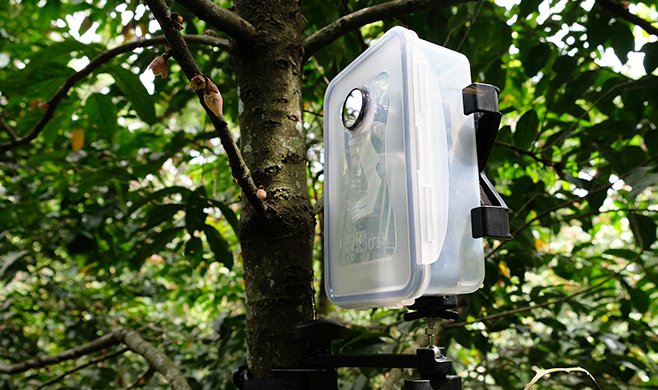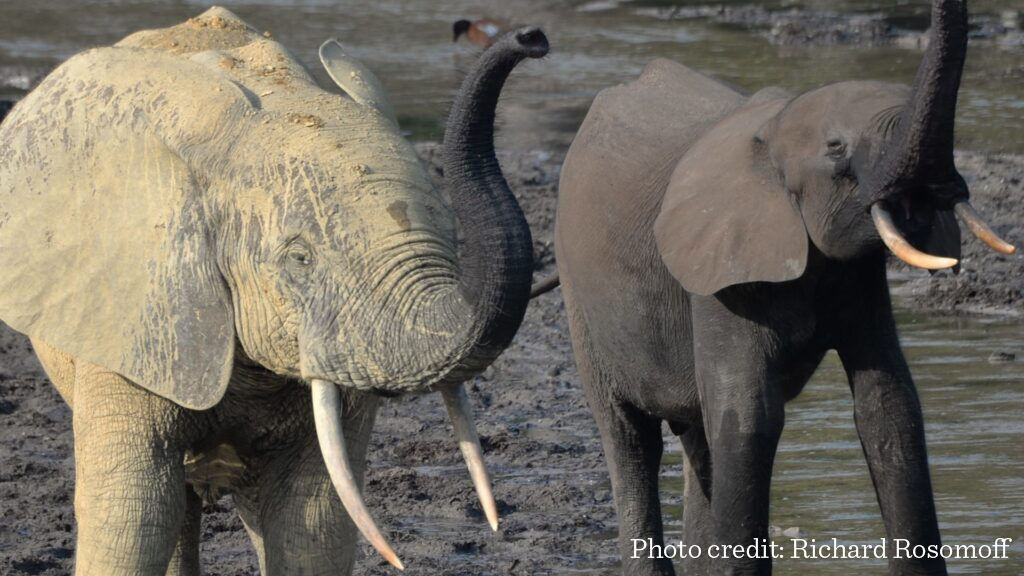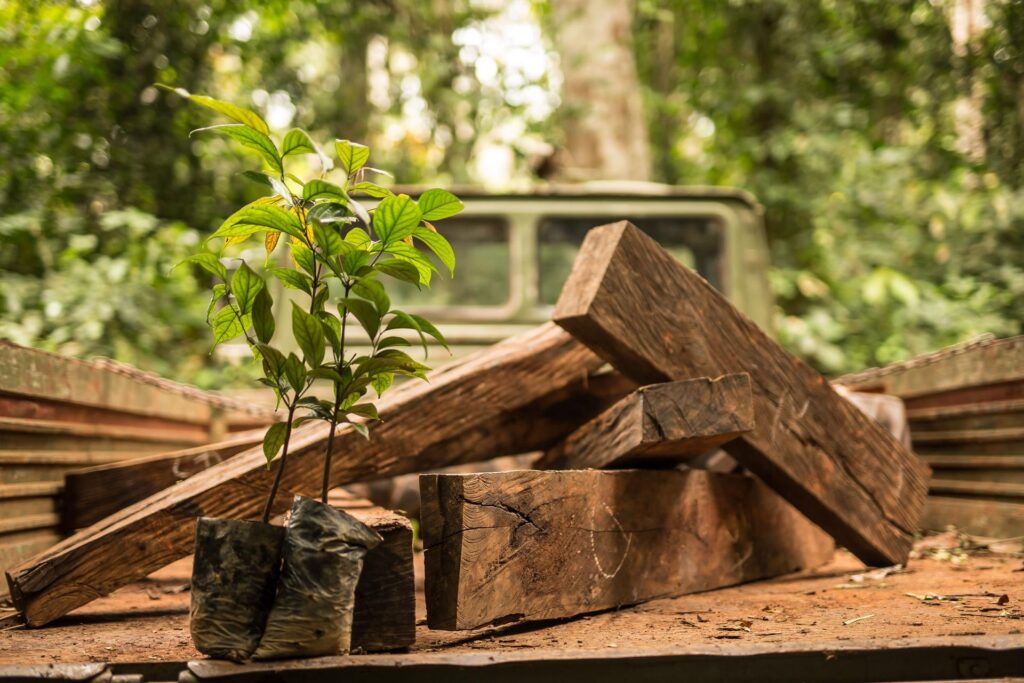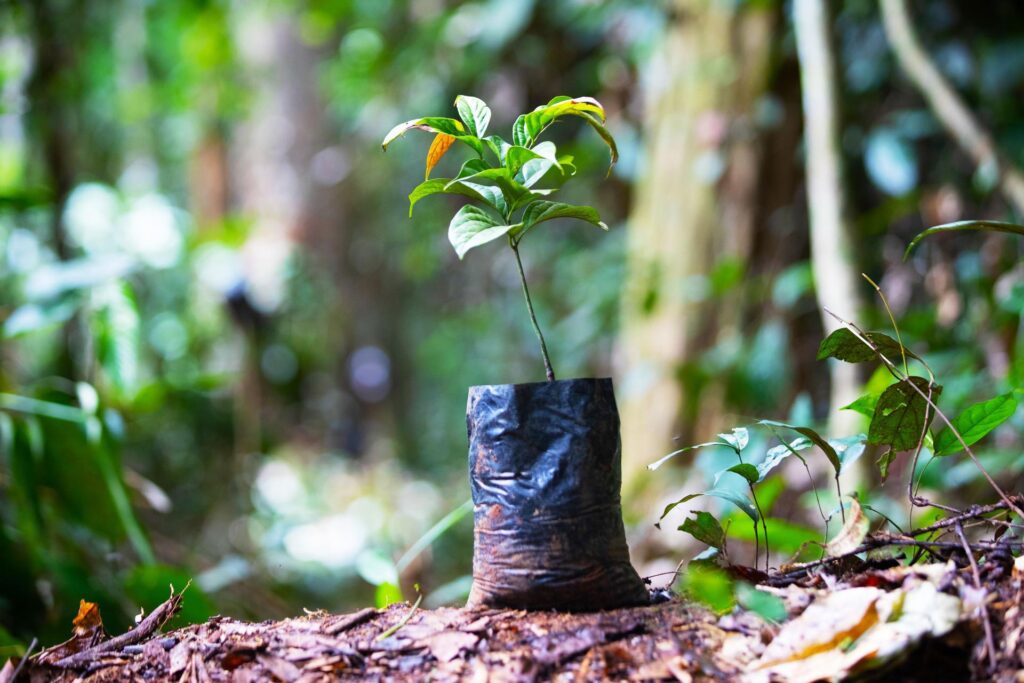In this article from Wood&Steel Winter 2019, Director of Natural Resource Sustainability Scott Paul highlights the latest developments with several sustainability-based initiatives, including the Ebony Project in Cameroon, koa reforestation in Hawaii, and rosewood’s protected status under CITES.
The Ebony Project
If you’re new to the story, all you need to know is that in 2011 Taylor Guitars and Madinter International purchased the Crelicam ebony mill in Yaoundé, Cameroon. Our goal was to create a legal and socially responsible value chain for ebony musical instrument components. In 2016, we partnered with the Congo Basin Institute (CBI) in Yaoundé to better understand the basic ecology of West African ebony (Diospyros crassiflora Hiern) and launched a community-based livelihood program focused on restoration of the species. In addition to ebony, the program also includes the planting of a number of locally used fruit and medicinal trees.
In our first three years we’ve had both successes and setbacks, but the highlights are that we are on track to reach our preliminary goal of planting 15,000 ebony trees by the end of 2020. As a step in that direction, this spring when the first rains come, we’re preparing to plant an additional 1,500 ebony plants and some 1,500 fruit trees, including avocado (Persea america), African cherry (Prunus africana), wild mango (Irvingia wombolu), ngoyo (Trichocypha acuminate), and papaya (Carica papaya). And by the close of 2019 we should also have five new communities participating in the project, raising that total number from two to seven.
The Ebony Project also continues to produce groundbreaking original research. For example, prior to this project, very little was known about what organisms pollinated ebony flowers or how seeds were distributed throughout the forest. In order to gain insight, special cameras were developed to see what we could discover. For the first time in history, ebony flowers were filmed from opening to wilting, documenting their full life cycle and capturing a variety of pollinators visiting the flowers, including insects such as nocturnal bees, moths and flies.
Camera traps were also deployed when the trees bore fruit, and in anticipation, Dr. Vincent Deblauwe conducted a literature review and consulted wildlife specialists. Dr. Deblauwe expects to confirm that mammals such as elephants, chimpanzees, gorillas and rodents served as seed dispersers. While no elephants or gorillas were filmed (gorillas are extremely rare in the current project region), cameras did document an interesting array of mammals eating or carrying off ebony seeds. Unfortunately, I can’t say more until the Congo Basin Institute releases a series of scientific papers. But I can tell you that Dr. Deblauwe did find elephant dung with ebony seeds germinating inside, confirming that elephants do indeed disperse the seeds. (Yes, Vincent likes to dig through elephant dung.)
Further, ongoing project research supports the hypothesis that over-hunting forest animals may be adversely affecting ebony’s natural seed dispersal. Dr. Deblauwe and his team believe that the loss of mammals that traditionally disperse ebony seeds may turn out to be one of the greatest long-term threats to ebony’s survival. If this is confirmed, without human-induced planting, natural regeneration of the species may be limited to areas in Central Africa where hunting and the bushmeat trade have not significantly reduced dispersal agent populations. Thus, any future plans to reintroduce elephants back into parts of their historic range may be impacted in part by the planting of a tree that produces one of their seasonally available traditional food sources, i.e., West African ebony.
Elsewhere, the Congo Basin Institute has created six study areas that represent a range of environments, from a small state-owned ebony plantation, to largely cut-over and hunted-out secondary forests, to intact pristine forest. The project has also produced the most comprehensive estimate of the total population size of the species, estimated at approximately 30 million individuals greater than 10 centimeters in diameter, and has reaffirmed that ebony is slow growing, taking approximately 35 years to reach reproductive maturity.
Finally, as previously reported, in addition to studying the ecology of ebony, we are also working to produce new ebony trees via seed collection, cuttings and tissue culture. In 2017, the second year of the project, Cameroonian ebony trees produced very few fruits, which limited the number of seeds that could be collected, but fortunately 2018 proved to be a phenomenal fruiting season, and over 20,000 seeds were secured. Before being transported to community nurseries, these seeds will be germinated at a newly constructed nursery at the IBAY SUP campus in Yaoundé, run by Dr. Zac Tchoundjeu, who is part of CBI and also a leading expert on agroforestry. Doctor Zac kindly named the new facility “The Bob Taylor Nursery.”
The project is also producing plants from cuttings, which, unlike seedlings, can be produced all year in Cameroon, although mortality rates at the rooting stage are still high. With further training we expect this to improve. Finally, regarding plant production, the project is pioneering tissue culture methods, and in the coming year Ms. Alvine Ornella Tchouga and tissue culture specialist Giovanni Forgione of the Congo Basin Institute will focus on refining protocols and begin to assess the success rate of plants transitioned from a sterile laboratory environment into organic soil in a sheltered outdoor setting.
At the most macro-level, the Ebony Project continues to garner interest from governments and inter-governmental institutions, raising questions about expanding the project beyond what Taylor is capable of supporting, across geographies and into different land usages. In the Winter 2018 edition of Wood&Steel, we mentioned that Taylor Guitars signed a Public-Private-Partnership agreement with the Cameroonian Minister of Environment, the Honorable Pierre Hélé, at the U.N. Climate Change Conference in Bonn, Germany, on November 14, 2017. The agreement has three basic steps. First, Taylor would continue funding the Ebony Project; second, the government of Cameroon would commission a feasibility study to better understand the opportunities and challenges to expanding the project; and third, if said feasibility study concluded that our little project could be expanded, then the government would seek to expand it. Taylor continues to fund the project, and we’re pleased to report that the feasibility study is now underway. The analysis might ultimately prove useful beyond Cameroon, too. For example, the government of Benin is in discussions with the Congo Basin Institute about implementing our project model there, although likely substituting ebony for another commercially valuable tropical hardwood species, as ebony does not grow in Benin.
Finally, our friends at Buck Knives (who formerly ran their factory just down the street from Taylor Guitars here in San Diego but have since moved to Post Falls, Idaho), are now selling their iconic Buck 110 Folding Hunter knife and other classic models made with Crelicam ebony. Many years ago Buck used ebony, later switching to an alternative material, but have now switched back to offer a more authentic, natural product. We are grateful that Buck Knives will be using Crelicam ebony, thus indirectly supporting Crelicam and the Ebony Project. In fact, in a further show of support, Buck Knives made a donation to the Conservation Action Network (CARN), a 501(c)3 established to help the Congo Basin Institute’s evidence-based conservation efforts.
Koa Reforestation in Hawaii
As last reported in the Summer 2018 issue of Wood&Steel, Bob Taylor purchased a 565-acre tract of pastureland on the flank of Mauna Kea on the Big Island of Hawaii with the dream to reforest it. To expedite the process, the property is being leased to Paniolo Tonewoods, a partnership set up between Taylor Guitars and Pacific Rim Tonewoods in 2015. This land was once a dense forest of koa and ʻōhiʻa trees, but over the years it was slowly converted to what is now largely open, rolling pasture. Today, it is primarily covered in non-native kikuyu grass (Pennisetum clandestinum), other introduced pasture grasses with a few remnant ʻōhiʻa trees on the edges of steep knolls. Simply put, the plan is to return this land to forest, with continuous small removals and replanting to produce koa logs in perpetuity for musical instruments, woodworking and traditional cultural purposes.
In October of 2018, this dream got a head start with the approval of the Paniolo Forest Management Plan by the State of Hawaii Forest Stewardship Committee, a group of forestry, land management and environmental professionals. We are especially grateful to Paniolo team members Nick Koch and Bob Rose, who pulled the detailed plan together. If everything goes accordingly, this spring the first 60 acres will be planted, representing roughly 10 times the number of dead, dying or malformed trees Paniolo has harvested since inception in 2015.
Finally, we hope that by the end of 2019 a small mill will be built on the property, allowing for increased value-added processing to occur in state. In the meantime, Paniolo continues to source wood from other private landowners in Hawaii who have previously existing reforestation projects underway. This work provides additional funding for fencing and other conservation activities.
CITES and Rosewood
As reported in our Winter 2018 issue (“A Closer Look at CITES Rosewood Regulations”), in October of 2016 in Johannesburg, South Africa, the Convention on International Trade in Endangered Species of Wild Fauna and Flora (CITES) voted to make a change in the protected status of rosewood. The decision was largely in reaction to the rapid loss of several rosewood tree species as the result of escalating Asian demand for hongmu furniture. The word “hongmu” means “red wood” in Chinese, and the term refers to a range of red-colored tropical hardwoods, including several rosewood species, used to produce a certain style of furniture. To protect these species, CITES responded by listing the entire Dalbergia genus (except for Brazilian rosewood, which was already listed in Appendix I), as Appendix II and created a new governing annotation.
Despite good intent, it soon become apparent that the new listing had several unintended consequences, and created a significant administrative burden for CITES management authorities. For example, consider that prior to the listing the U.S. Fish & Wildlife Service processed on average roughly 20,000 CITES permits per year for items made with any number of plant or animal parts or extracts covered by the Convention. One year later the number jumped to approximately 40,000, and by the time of the CITES Standing Committee in Sochi, Russia, in October 2018, it had reached 60,000. The increase in permits was virtually all attributed to musical instruments, mostly guitars. Why so many permit requests? Well, you need a CITES permit when you take a CITES-controlled species across an international border, and I’m hard-pressed to think of an item as more commonly owned, more traveled with, more portable, and more bought and sold internationally than a musical instrument.
To be clear, Taylor Guitars is very supportive of CITES, and we do endorse the Convention taking action on Dalbergia issues. This said, it’s fair to say that no other sector was more adversely impacted than the music industry, even though neither musical instruments nor the specific species of rosewood that our industry most commonly uses were issues of concern leading up to the listing itself.
Anyway, it’s been a mess, but since the gathering in South Africa, CITES has met regularly in various intersessional settings to discuss various aspects of the convention’s implementation, and a small but dedicated group of instrument manufacturers and representatives from performing ensembles has been there. Taylor has been there, too, and in part due to our collective presence, concern surrounding the rosewood listing has been front and center. We’re optimistic that relief for our sector may be on the horizon when CITES meets next in Sri Lanka in May of 2019. Everyone at CITES understands that it’s a problem, and it seems that everyone wants to fix it.































































